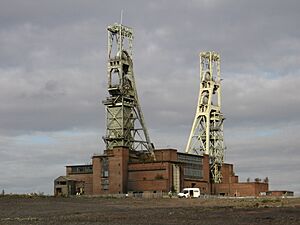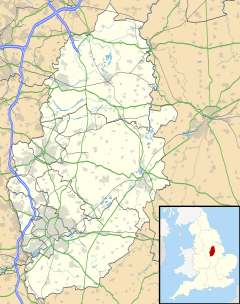Clipstone facts for kids
Quick facts for kids Clipstone |
|
|---|---|
| Village and civil parish | |
 Clipstone Colliery disused headstocks |
|
Parish map |
|
| Area | 1.39 sq mi (3.6 km2) |
| Population | 6,185 (2021) |
| • Density | 4,450/sq mi (1,720/km2) |
| OS grid reference | SK 585635 |
| • London | 120 mi (190 km) SSE |
| District |
|
| Shire county | |
| Region | |
| Country | England |
| Sovereign state | United Kingdom |
| Post town | MANSFIELD |
| Postcode district | NG21 |
| Dialling code | 01623 |
| Police | Nottinghamshire |
| Fire | Nottinghamshire |
| Ambulance | East Midlands |
| EU Parliament | East Midlands |
| UK Parliament |
|
Clipstone is a village in Nottinghamshire, England. It is located in the Newark and Sherwood district. It was once a very important mining village.
In 2001, about 3,469 people lived in Clipstone. This number grew to 4,665 by 2011. By 2021, the population had increased even more to 6,185 people.
Contents
History of Clipstone
The first time Clipstone was mentioned in writing was in the Domesday Book of 1086. This was a big survey of England ordered by William the Conqueror. The village was called "Clipestune" back then.
The name Clipstone probably comes from an old Norse name, Klyppr. It also includes the Old English word tun, which means an enclosed farm or settlement. So, it likely means 'Klyppr's farm or settlement'.
Ancient Times in Clipstone
The oldest things found in Clipstone are from the Bronze Age. These include a spearhead and an arrowhead. There's also a suspected ring ditch nearby. This might be the remains of an ancient burial mound.
From the Iron Age, experts have found patterns in the ground from the air. These patterns show old field systems and animal pens. This suggests people were farming and raising animals here a very long time ago.
Roman Period
People have found Roman pottery in Clipstone. They have also found two Roman brooches and a small collection of Roman coins. This shows that Romans were active in the area.
Close by, in Mansfield Woodhouse, there might have been a Roman road. There was also a Roman marching camp. Further away, a small Roman villa was found in 1780.
Early Medieval Period
Some pieces of old pottery from the late Saxon period were found in 1991. Before the Domesday Book, two important people named Osbern and Ulsi owned land in Clipstone. Ulsi was quite a rich landowner.
Domesday Book
In 1086, a powerful Norman landowner named Roger de Busli owned the land in Clipstone. He owned many estates across Nottinghamshire and other areas.
King John's Palace
King John's Palace is a set of ruined walls. It was once a royal home used for hunting trips. It is located near Kings Clipstone, close to Sherwood Forest.
Even though we can't be totally sure King John built it, there was a large deer park nearby. Kings and queens used this park for hunting. It is said that King John held a meeting here in 1212. King Edward I also held a meeting here in 1290. The ruins of the palace were even shown on the TV show Time Team.
Industrial Growth
In the 1600s, an ironmaster named George Sitwell mined iron in the area. He also built a furnace here.
Clipstone Riot
In 1767, much of the local forest was managed by the Duke of Portland. He used it to produce timber. At this time, some local people were causing trouble in the forest.
In 1767, workers from nearby villages were involved in the Clipstone Riot. The Duke of Portland was trying to make more money from the forest. This meant local people might have lost some of their rights to use the timber. This change might have caused the riots.
About Clipstone Today
Clipstone is divided into two main areas. These are New Clipstone and Kings Clipstone. New Clipstone is about four miles from Mansfield town. Kings Clipstone is a bit further away.
Kings Clipstone used to be called Old Clipstone. In 2003, its old name, Kings Clipstone, was brought back. It was then separated for local management. Both parts of Clipstone are located along the B6030 road.
Kings Clipstone is the oldest part of the village. It has a rural feel with some old stone buildings. It is known for being quite 'undeveloped'. The local Dog and Duck pub is the only place for people to meet up there.
New Clipstone (often just called 'Clipstone') is a more mixed area. It has both old and new homes. There is a library, a primary school, and a village hall. You can also find a few shops and pubs here. One pub, Clipstone Welfare, was even used for scenes in the 2007 film Control. The old Clipstone Colliery site is in New Clipstone. Its tall headstocks are still a very noticeable landmark.
On the edge of the village is Vicar Water Country Park. This park was created from an old lake and the former spoil tips (piles of waste) from the coal mine. It now has hills and ponds. There is also a sculpture called the 'Golden Hand'. It is meant to represent the village's mining history.
Most of the village is in the Newark and Sherwood district. A small part is in the Mansfield council area. The Garibaldi College is just inside the Mansfield district.
The local football team is Clipstone Welfare. The village is also very close to Sherwood Forest.
Clipstone Camp
Clipstone Camp was built on the land where Clipstone Colliery would later be. Work on the mine started in 1912 but stopped when the First World War began. The Duke of Portland offered the land for use as a military training camp. It opened in February 1915.
The first soldiers to train there were the Royal Fusiliers. At its busiest, the camp could hold 30,000 soldiers! The camp had separate areas for different groups of soldiers. Each area had sleeping quarters, kitchens, dining rooms, and parade grounds. Soldiers practiced in mock-trenches and on gunnery ranges. They could also swim in Vicar's Pond for fun.
After the war ended, some soldiers at the camp were unhappy about how slowly they were being sent home. This led to some unrest. Plans began in 2013 to create a memorial for those who trained in Clipstone.
Clipstone Colliery
The Clipstone coal mine closed in April 2003. Since 1993, it had been owned by RJB Mining, which later became UK Coal. The tall structures above the mine shafts, called headstocks, were finished in 1953. At that time, they were the tallest in Europe! You can see them from many miles away.
The headstocks are now protected as Grade Two listed structures. This means they are important historical buildings. There were attempts to pull them down because they were expensive to maintain. However, many people wanted to save them. In 2014, a petition was started to get public support to save them.
In December 2020, a company from Mansfield bought the buildings, headstocks, and land. They plan to save the headstocks and turn the area into a "multi-purpose leisure facility." This means it will be a place for different fun activities.
Clipstone Colliery Sidings railway station was the train station that served the mine. In 2022, a TV show called Without Sin was partly filmed in Clipstone. Some scenes were filmed in the village, including a party in the old colliery.
Images for kids




